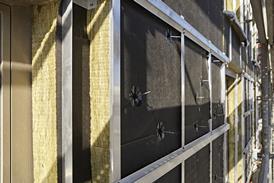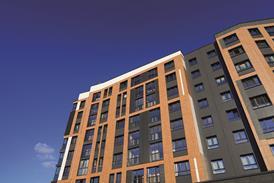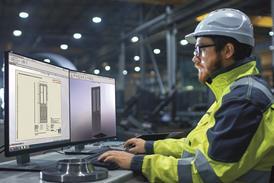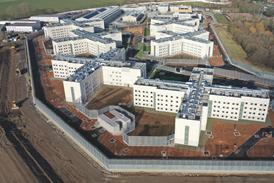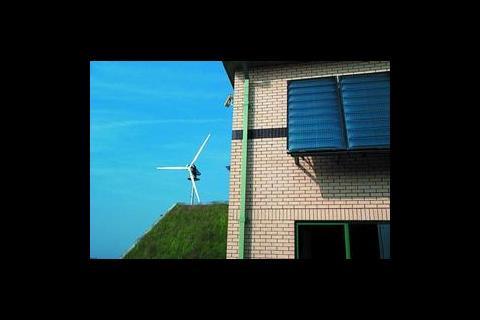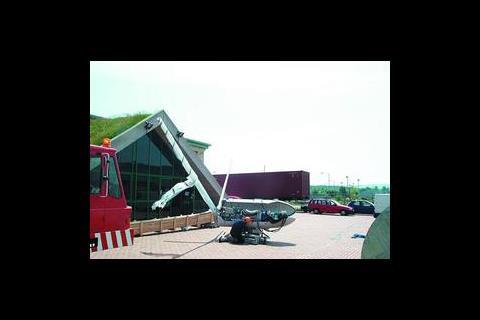In the UK, wind farms located on rural high ground currently provide an electrical capacity of over 350 MW. Clearly, there is huge potential for expanding this capacity, however factors such as planning restrictions have reduced the pace of the development of wind projects, usually due to the visual impact of the large turbine structures. In order to overcome sensitive planning concerns, and also to take advantage of improved wind conditions, wind energy developers are beginning to look at sites off the UK coastline for future projects. The downside is that offshore constructions typically involve substantially higher civil and grid connection costs.
Another approach is to develop wind energy within the urban environment where the visual impact of turbines in built up areas can often be less contentious than proposed sites on the rural landscape. There are clear advantages to integrating specially designed wind turbines into (or adjacent to) buildings for the purpose of directly supplying the end-user with their electricity needs: building integrated wind energy brings renewable energy generation closer to the point of consumption (thus reducing transmission losses), their presence can help to raise awareness of energy consumption issues, and their application can reduce dependence on the grid. Building integrated wind energy generation has the potential to open up a whole new scope for integrating renewable energy into buildings.
Small scale, big potential
Wind turbines for building integration or installation in urban areas are much smaller than the turbines used in rurally located wind farms. 'Small' wind turbines refers to machines from a few Watts to 20 kW: applications such as 12 V battery charging would use small turbines with rotors of 0·5-1 m in diameter. Turbines between 1 kW and 5kW can be used to provide 12 V dc or ac output whereas larger machines, up to 20 kW for example, can directly contribute to the electricity demands of industrial installations.
The small wind turbines are less visible than multi megaWatt installations and are financially within reach of the electricity users. Producing small-scale electricity onsite to supply demand has significant economic advantages per kW installed, as the price of the electricity offset by the user is always higher than the price that would be given when selling to the grid.
Generally wind turbines are sited on high towers in open areas in order to capture the high velocity and laminar wind conditions. The built environment causes complex local flow conditions as the wind passes over, around and between buildings. Therefore, introducing wind turbines into the built environment must take into account such complex wind characteristics and high turbulences that are caused by the buildings themselves. Siting conventional horizontal axis wind turbines in built up areas typically produces less energy due to lower wind speed, varying wind direction and turbulent flows.
In many circumstances however, the effects of buildings on the local wind characteristics can be used to the advantage of capturing wind energy around a building: research studies have shown that deliberately entraining wind through the blades of a turbine can enhance wind energy generation by up to 20%. Therefore, wind turbines integrated in buildings could utilise the building design to actually improve turbine efficiency. The height of the building itself can also be used advantageously by reducing the requirement for tall turbine towers.
Capturing city wind
Some small-scale horizontal axis wind turbines have been designed with the application on urban integration in mind. Examples are the 5 m diameter rotor size of turbines installed on the roof of the Dutch EXPO. However, they are not always best suited to changing wind directions and turbulent conditions. Wind loadings and vibration transmitted through the turbine tower mean these extra forces have to be considered when designing the buildings.
Vertical axis wind turbines have been around for some time but have received less attention due to their lower efficiency per blade area and the lower suitability to large-scale power generation.
Modern small vertical axis wind turbines are available in different forms such as the Savonius and Darrieus rotor designs. These vertical axis machines are less affected by changes in wind direction and turbulent conditions and therefore offer great potential for integrating with buildings. The vertical axis machines are well balanced and have high output power-to-weight ratios, thus reducing the associated wind loading and vibration subjected to buildings that are fitted with horizontal axis machines.
The vertical axis machine is well suited to building integration due to the generator being located below the rotor therefore presenting the opportunity for the generator to be installed within the building structure. There are also opportunities for attractive aesthetic design using vertical rotor blades. Suitable, commercial vertical turbines are less developed than their horizontal counterparts, however due to their suitability for building integration it is expected that new designs will emerge in the forthcoming years.
Working with other sources
Wind turbines can complement other renewable sources of energy such as solar thermal systems, building integrated photovoltaic (pv) panels and ground source heat pumps. The cost of installed wind turbines is many times less than pv for equivalent energy output and therefore can offer a genuine solution to offset a building's electrical demand from the grid.
Apart from the obvious planning constraints in certain urban areas there are other factors that affect the installation process. For building integrated wind energy there will be more people involved in the installation process than for developing wind farms.
The parties involved in such building integrated wind energy projects would be the building owner, energy supplier, architect, site managers, building users and neighbouring building occupants. The requirement to include all such parties must be considered when planning projects.
Case study: energy on site
To date very few examples of building integrated wind installations are demonstrated in the UK, however a few turbines have been installed in the built environment. An example is a 20 kW horizontal axis wind turbine that was installed at a factory in South Wales by Sustainable Energy Ltd.
The factory is located on a business park and therefore had little objection at the planning permission stage and was generally viewed positively as making a contribution to reducing global carbon emissions. The client's environmental policy was the driving force behind the project, however it stacked up economically with assistance from the European Regional Development Fund (ERDF) provided via an energy savings scheme operated by the local energy utility, United Utilities (formerly known as SWALEC).
The size of the turbine to supply the eco-factory was selected by considering the electrical demand and local wind resource at the site. The turbine position was considered by assessing the effect of wind obstacles and turbulence, sound levels at neighbouring buildings, location of the control cabinet and site access. The turbine selected for the eco-factory was a UK manufactured Gazelle 20kW horizontal axis turbine.
Specifications for the turbine were:
- 14·5m tower
- three blades each of 11 m rotor diameter
- cut-in speed 4 m/s
- cut-out speed 20 m/s
- power output: 3-phase 400/415 V
The turbine, located on a site with an average wind speed of 5-6 m/s can generate over 50 000 kWh per annum. Once the turbine and site position had been determined, the application for planning permission was prepared, comprising a description of the project; a plan of siting position of the wind turbine; a plan of the extent of land ownership; drawing of the turbine showing dimensions; photographs of the turbine to highlight scale and appearance and evidence of noise levels.
An environmental impact assessment was not required for this turbine since it was less than 15 m in height.
The reinforced concrete foundation (laid by a local contractor) had a horizontal surface of 4 m x 4 m with a depth of 1 m. Protruding anchor bolts were set into the concrete base and a 152 mm duct was run from the base to the building where the control cabinet was to be installed. Earth nests were located at each of the four corners of the foundation.
The turbine tower and nacelle (gearbox and generator) were delivered to the site, access ladder and maintenance platform fitted to the tower and two of the three blades fitted to the nacelle.
The tower was lifted into place using an 18 tonne crane. Once the tower was in place, the nacelle and two of the blades were lifted and fitted onto the tower, followed by the third blade. After installation of the turbine and the electrical system, the wind turbine was commissioned. Commissioning was carried out including the G59 tests that examine the brake and safety systems of the turbine while being witnessed by the local distributor network operator.
Table 1 shows cost breakdown for the turbine. Forty percent of the total cost of the project was funded via a grant made under an energy savings scheme supported by the ERDF and managed by United Utilities.
The client is committed to pay back the remaining balance of the project costs over a five year period, after which time the turbine shall deliver direct savings to the client.
When accounted as offsetting electricity demand the revenue saved could be £3,000 per annum, providing a simple payback period of about eight to nine years.
Source
Building Sustainable Design
Postscript
Gabriel Gallagher BEng PhD is technical director of Sustainable Energy Ltd. His specialisms include R&D, biomass and wind energy. Sustainable Energy offers renewable energy and energy efficiency products and services. For more information, their web site is www.sustainable-energy.co.uk










